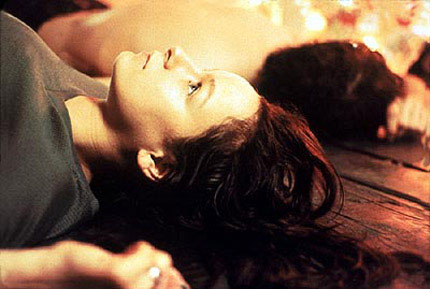The Passion of the Christ

The Jesus myth (and I don't mean to imply anything with regard to historical fact with that term, I never liked the idea that myths aren't true, as if that matters) is a remarkable depiction of one of the essential human conflicts: that between body and soul; our mortal, frail bodies and our knowledge of that mortality. To go to one's death willingly is a victory of the spirit over death.
The idea that Christ was fully man as well as fully god is surely in some ways a reflection of our need to face mortality, and our desperate desire to overcome it. Gibson's film is as intense a depiction of that conflict as I have ever seen, not due to any particular artistry on Gibson's part, but more as a testament to the unmatched empathetic power of cinema. His Christ is
of this world as well as in it, and I think this reflects a pretty mature Catholic understanding of the scriptures on Gibson's part. All in all, the film seems to me a meditation on the body and blood of Christ, a filmic depiction of the eucharist.
Jesus was, for me, almost a non-presence in the iflm. As I noted above, it's more his physical presence than his personality, or even his love for mankind that sticks in the mind. The jewish actress that plays Mary, on the other hand, gives one of the greatest depictions of feminine and motherly love since, well...ever. I was strongly moved emotionally by the film, but for the most part only when Gibson focuses his camera with unique intensity, and with what seemed to me passionate adoration, on Mary's beautiful face full of motherly compassion. It's that image that all suffering looks to for comfort, and for the longing embrace of the
pieta.
Anti-semitism? I don't know. Isn't the story inherently anti-semitic? I didn't feel that this movie went beyond that, but I also don't know what to look for. Considering that movie is similar in tone to medieval passion plays I think perhaps the anti-semitism was remarkably subdued!!
I feel many, many non-believers will be shocked by this movie. It
is uncomfortable to confront that kind of intensity when you don't feel it yourself. I've always been fascinated by and respectful of that sort of thing. One thing I fear is that many people get off on the sadism, they will hear a mantra, "all for me, all for me" rather than, what I think is just as appropriate, "all caused by me, all caused by me." That paradox is also perhaps at the heart of the matter, but then I am starting to get a bit beyond just the movie.
Is it great art? No, I don't think so. Gibson lacks that special inspiration, and I feel that perhaps his intensity of devotion to his faith can find no other expression than this bludgeoning, punishing film. There was no moment of transcendence. (Maybe they should screen Bresson's
A Man Escaped right after for a depiction of humanity transcending mortal bounds.) Nevertheless, it's a remarkable document.










